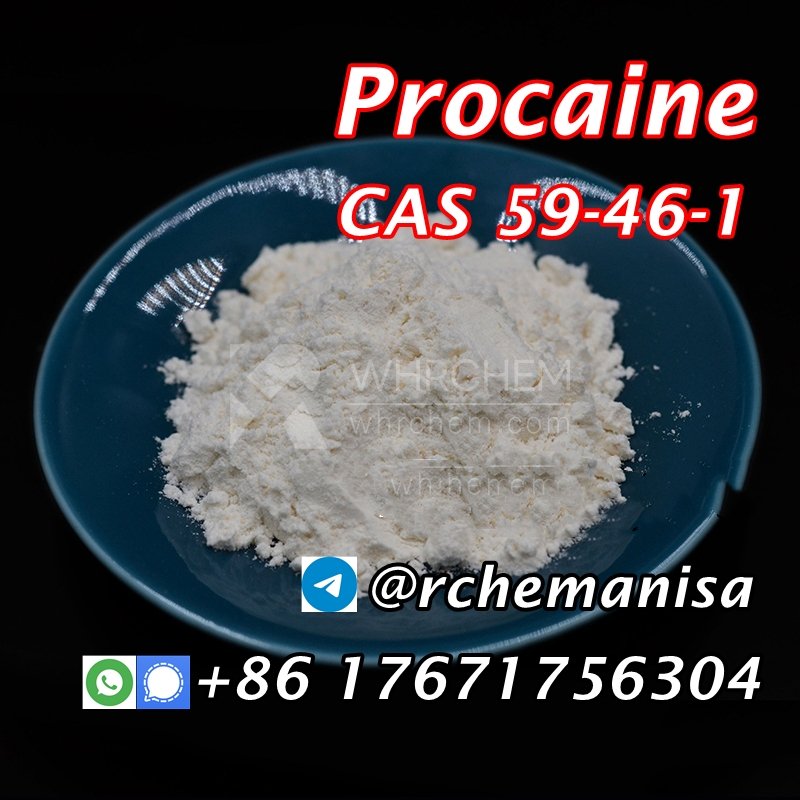Procaine CAS 59-46-1 Novocaine
Procaine CAS 59-46-1 Novocaine is a local anesthetic drug of the amino ester group, hot selling with high quality.
CAS 59-46-1 Basic Parameter
| Product Name | Procaine |
| Synonyms | 2-(Diethylamino)ethyl 4-aminobenzoate;2-(Diethylamino)ethyl p-aminobenzoate;2-(diethylamino)ethylp-aminobenzoate;2-diethylaminoethyl4-aminobenzoate;2-Diethylaminoethylester kyseliny p-aminobenzoove;2-diethylaminoethylesterkyselinyp-aminobenzoove;2-diethylaminoethylp-aminobenzoate;4-Aminobenzoic acid diethylaminoethyl ester |
| CAS NO | 59-46-1 |
| Molecular Formula | C13H20N2O2 |
| Molecular Weight | 236.31 |
| Melting point | 61°C |
| Boiling Point | 373.6°C at 760 mmHg |
| Flash Point | 179.8°C |
| Density | 1.077g/cm3 |
| Assay | 99% |
| Grade | Pharmaceutical Grade |
| Solubility | 9.45g/L(30 ºC) |
| Appearance | White Crystalline Powder |
Novocaine Picture

What is Procaine?
Procaine is a local anesthetic drug of the amino ester group. It is most commonly used in dental procedures to numb the area around a tooth and is also used to reduce the pain of intramuscular injection of penicillin. Owing to the ubiquity of the trade name Novocain or Novocaine, in some regions, procaine is referred to generically as novocaine. It acts mainly as a sodium channel blocker. Today, it is used therapeutically in some countries due to its sympatholytic, anti-inflammatory, perfusion-enhancing, and mood-enhancing effects.
Procaine was first synthesized in 1905, shortly after amylocaine. It was created by the chemist Alfred Einhorn who gave the chemical the trade name Novocaine, from the Latin nov- (meaning “new”) and -caine, a common ending for alkaloids used as anesthetics. It was introduced into medical use by surgeon Heinrich Braun.
Prior to the discovery of amylocaine and procaine, cocaine was a commonly used local anesthetic. Einhorn wished his new discovery to be used for amputations, but for this surgeons preferred general anesthesia. Dentists, however, found it very useful.
Pharmacology
The primary use for procaine is as an anaesthetic.
Aside from its use as a dental anesthetic, procaine is used less frequently today, since more effective (and hypoallergenic) alternatives such as lidocaine (Xylocaine) exist. Like other local anesthetics (such as mepivacaine, and prilocaine), procaine is a vasodilator, thus is often coadministered with epinephrine for the purpose of vasoconstriction. Vasoconstriction helps to reduce bleeding, increases the duration and quality of anesthesia, prevents the drug from reaching systemic circulation in large amounts, and overall reduces the amount of anesthetic required. As a dental anesthesic, for example, more novocaine is needed for root canal treatment than for a simple filling. Unlike cocaine, a vasoconstrictor, procaine does not have the euphoric and addictive qualities that put it at risk for abuse.
Procaine, an ester anesthetic, is metabolized in the plasma by the enzyme pseudocholinesterase through hydrolysis into para-amino benzoic acid (PABA), which is then excreted by the kidneys into the urine.
A 1% procaine injection has been recommended for the treatment of extravasation complications associated with venipuncture, steroids, and antibiotics. It has likewise been recommended for treatment of inadvertent intra-arterial injections (10 ml of 1% procaine), as it helps relieve pain and vascular spasm.
Procaine is an occasional additive in illicit street drugs, such as cocaine. MDMA manufacturers also use procaine as an additive at ratios ranging from 1:1 up to 10% MDMA with 90% procaine, which can be life-threatening.
Synthesis
Procaine can be synthesized in two ways.
- The first consists of the direct reaction of the 4-aminobenzoic acid ethyl ester with 2-diethylaminoethanol in the presence of sodium ethoxide.
- The second is by oxidizing 4-nitrotoluene to 4-nitrobenzoic acid, which is further reacted with thionyl chloride, the resulting acid chloride is then esterified with 2-diethylaminoethanol to give Nitrocaine. Finally, the nitro group is reduced by hydrogenation over Raney nickel catalyst.
Contact Anisa:
WhatsApp/Signal: +86 17671756304
Telegram: @rchemanisa
Element: @rchemanisa:matrix.org
Website:https://bmf-49851-31-2.com
Session: 05468ee84b6ca5c619560e29a92e664c358c08b4ea5c6c2d5d88f39e8c87dcb407







Reviews
There are no reviews yet.